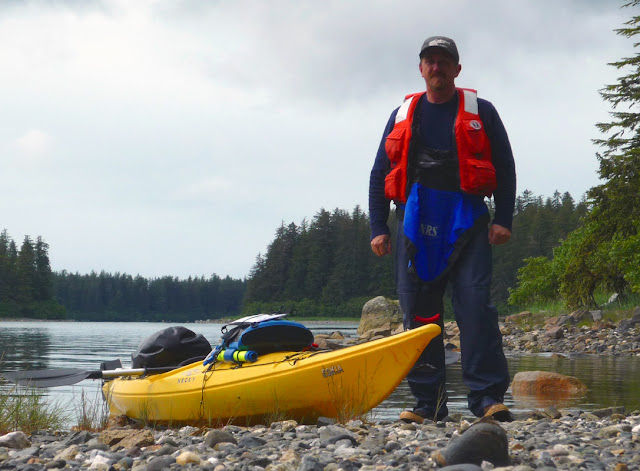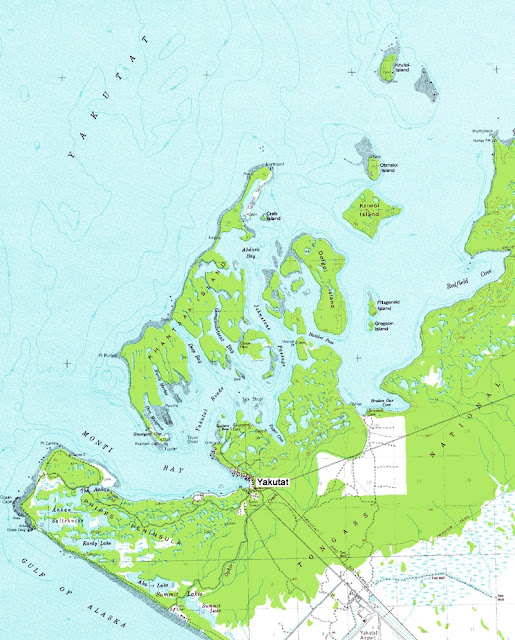
On a clear day Yakutat Bay’s northern skyline is dominated by the mountains of the Wrangell-St. Elias National Park and Preserve and rising above all others stands Mount Saint Elias the second highest mountain in both the United States and Canada at 18,008 ft (5,489 m). Named Yaas'éit'aa Shaain by the Tlingit, the mountain was first climbed in 1897 by an expedition led by famed explorer Prince Luigi Amedeo Giuseppe Maria Ferdinando Francesco di Savoia-Aosta, aka The Duke of the Abruzzi.

The City of Yakutat, population 656, is now located at the end of Monti Bay and receives dally air service via Alaska Airlines and regular ferry service from the Alaska Marine Highway System. Yakutat's economy is based largely on fishing, fish processing, government and visitor services including lodges, inns and charter fishing for both saltwater and fresh. Fishing in the Situk River is considered world-class and attracts many anglers every year. Many year round residents depend on subsistence hunting and fishing to augment their personal income

On the south side of the bay is the village of Yakutat surrounded by a small archipelago of sheltering islands. Over the past two centuries the village’s location has moved several times due to availability of food, trade, warfare and economic opportunity from commercial fishing and sea food processing. Aside from private and native owned lands the area surrounding Yakutat is under the management of the Tongass National Forest and, as of yet, has seen little in the way of large scale logging or development.
The Yakutat community maintains a strong traditional Tlingit culture, about half of the area’s population is Alaska Native or part Native. The Yakutat Tlingit are organized under Yak-Tat Kwaan, Inc., the village corporation that was formed as a result of the Alaska Native Claims Settlement Act, as well as the Yakutat tribal government. Traditionally there are five major clans of extended families that are based on matrilineal lines in the Yakutat area: Teikukeidi (Brown Bear), Lunaxadi (Silver Salmon), Shunkukeidi (Thunder Bird), Kwaashkikwaan (Humpback Salmon) and Galix Kaagwaantaan (Beaver and Wolf). This totem pole, located on a beautiful local trail, is a memorial pole for a mother’s lost son and is testament to the community’s commitment to its traditional roots, values and culture.

The Yakutat and Southern Railroad was unusual in that its sole freight commodity was raw fish. The railroad’s schedule was totally depended not only on the fishing season but the twice daily tide and did not run during the winter months. Beginning in 1903 fishermen would bring their salmon to a slough on the Situk River and then load it onto the Y&S train. The train would then hall the fish 11 miles north to Yakutat where they would be canned and shipped to US markets. Today the engine and a few cars can be found in a city park near the center of town and the old rail bed has since been turned into a hiking trail, but if you plan to take a walk you will probably want to bring your bear spray as the bears like to walk there too.
Every year Humpback whales arrive during the summer to feed on the abundant schools of herring in the bay. Seals and sea lions haul out on crowded rocks, and harbor porpoises dive for fish in the channels and lagoons. Even if you go by yourself, you are never really alone when you are out on the water.
A stopover and breeding ground for over two hundred species of birds, Yakutat is an ideal destination for the avid naturalist and bird watcher. You may want to check out the Yakutat Tern Festival that gets going in late May. If you do plan a visit be sure and bring your binoculars and checklist as every spring the bay comes alive with our avian friends, such as these Black Legged Kittiwakes in Disenchantment Bay.
A trip to the end of Disenchantment Bay will bring you face to face with the largest tidewater glacier in Alaska. The sprawling Hubbard Glacier is seven miles wide at its terminus and over forty miles long spilling down from the surrounding mountains. Icebergs choke the upper bay and it took several hours for us to weave our way up to the looming cliffs of ice. If you don’t have the time or inclination to paddle all the way up from Yakutat, about 60 miles one way, reliable charter service is available from Yakutat Charter Boat Company. They offer a full day excursion up to the face of the glacier and back at a very reasonable price. Kayak drop off and pickup can be arranged for an additional charge.

The face of the Hubbard Glacier is about ten stories tall. When the ice fractures and lets loose it sends huge chunks crashing into the sea with thunderous sounds. On occasion, bergs would break off underwater, sending “shooters” rocketing up from the depths. This calving happens often, so good judgment should be used when approaching the glacier's face. During this trip, the gap between the surging glacier and the entrance to Russell Fjord was open, but far too narrow to safely pass, so we spent an hour enjoying the deep blues of the glacial ice and watching harbor seals nurse their pups on the surrounding icebergs.
While in Yakutat I stayed at Leonard’s Landing Lodge. Located in the center of the surrounding islands, it’s a perfect spot to explore the area by kayak. Single and double kayaks are available for lease from the lodge by the hour or day. The owners and staff were very helpful in providing all necessary gear, arranging transportation and sharing their local knowledge. Their tidy rooms were reasonably priced and they have more exclusive beach front cabins as well. Maybe I’m just getting old and soft but I could sure get used to returning to camp with a hot shower and clean bed instead of just tenting it.

The islands were a delight to paddle with the stunning backdrop of the Saint Elias Range in the distance. A great number of birds were nesting on the edges of the islands including Arctic and Caspian Terns. The wildlife, both marine and terrestrial, was amazingly abundant. I searched for but found little evidence of the old village sites, long gone, swallowed up by the dense rainforest.
One of my favorite places I explored was the Anaku Lagoons on the Phipps Peninsula just south of town. There are lots of intriguing salt chucks and hidey holes back in there, so I had to play the tides just right to get all the way back to the farthest lake. I also had to pay keen attention to my map to avoid getting lost amongst all the twists and turns.
Calm and serine, starfish, anemones and long strands of slowly waving kelp passed beneath my hull while small fish and hermit crabs scurried for cover. From the forest above, the songs of many different birds drifted down through the canopy. Sitka Blacktail deer unaware of my approach grazed on sedge grasses along the water’s edge. A small school of salmon swirled around at the entrance of a stream. Paradise!
From a narrow spot on the south end of Kardy Lake I was able to hike over to the vast beaches on the pacific side. If I ever go back to Yakutat, it will probably be to hike and camp along that shore. It was really quite beautiful.

Paddling through the island and bays I would often try and imagine the days, not too long ago, when canoes were the only form of transportation and Yakutat bay was occupied exclusively by its first inhabitants. Before arriving I began reading Under Mount Saint Elias: The History and Culture of the Yakutat Tlingit by Frederica de Laguna. Reading her monumental three volume ethnographic work, first published by the Smithsonian Institution in 1972, helped give me a window into the past and a deeper appreciation for this remarkable place and its people.
Book 1, Book 2, Book 3 (photos)
"We dedicate this to the greatness of your ancestors, and to bright hopes of your children and grandchildren." - Frederica de Laguna









